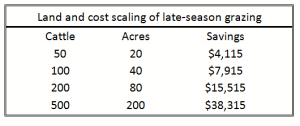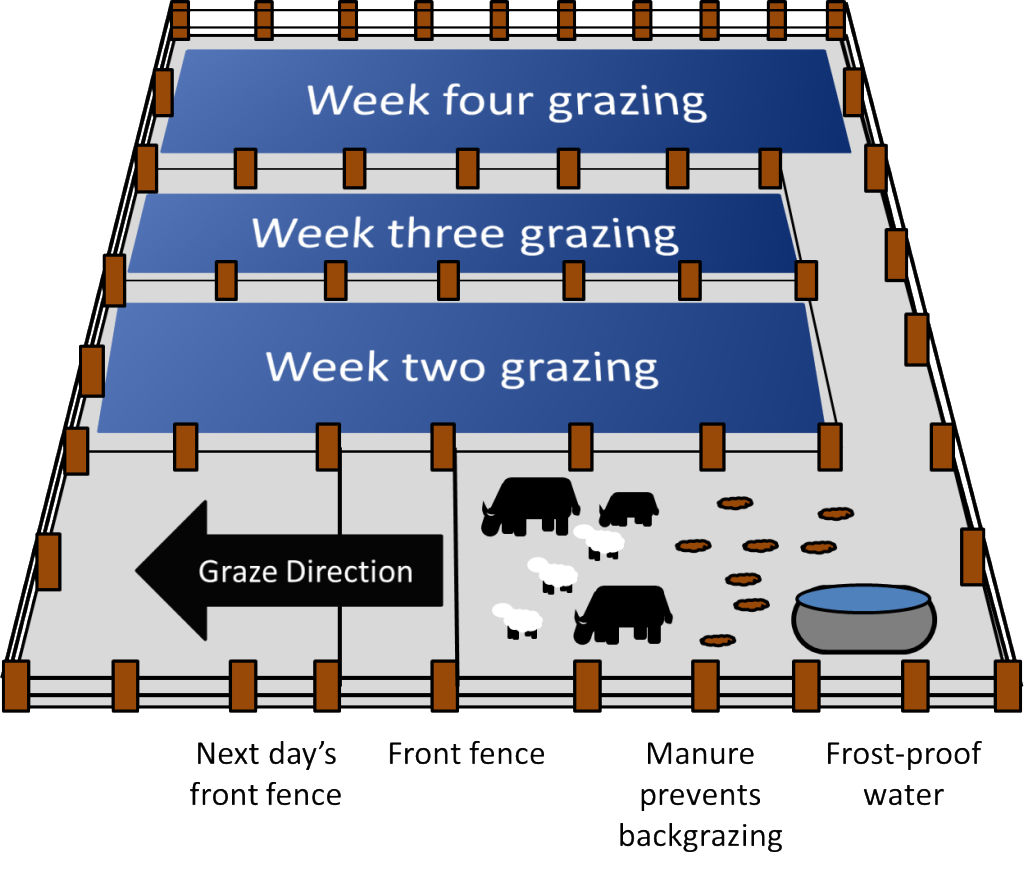The cost of feed and hay is one of the largest expenses for livestock producers in the Algoma region. With an average of six months of snow coverage per year, overwintering costs can quickly become a burdensome expenditure for a small business. Pasturing your animals after the frost begins is a good way to save labour and feed-related costs on your farm.
However, grazing your animals through Autumn and into Winter requires planning efforts to ensure that the pasture is ready for Springtime production.
In this newsletter we discuss a few ideas and practices which Algoma farmers can use to reduce the costs associated with feeding their animals over the Winter months.
Better land use planning over time Stockpiling and late-season grazing come from a set of principles used in self-sufficient land use practices generally referred to as managed-intensive grazing. These farming methods are rooted in long-term planning and emphasize simple and effective ideas that are less destructive and more beneficial to both the farm’s ecology and the businesses’ bottom line. What these principles aim to do is create a working landscape through thoughtful planning. While the farm work does still need to be done, it can either be done less often (e.g., such as haying/baling) or more effectively (e.g., manure spreading through late season grazing) by using managed-intensive grazing methods.
Stockpiling is a practice that saves pasture forage for use at a later time, specifically late season. Essentially, this involves utilizing un-grazed paddocks for forage in October, November and perhaps even December. The stockpiled pasture should be allowed to rest (i.e., not grazed) in the spring and modestly grazed from June through mid-July, increasing the establishment of root systems and drought tolerance of fields. Stopping grazing in mid-July in Algoma allows sward yield to increase, provides the opportunity for some plant species to disperse seed (e.g., birdsfoot trefoil), improves pasture health over the long term, and reduces the costs of reseeding. Grazing on this pasture then resumes in the late fall and can continue until the snow becomes too deep. If the fall season is wet, it is better to wait until the frost sets in as grazing soft ground can damage the pasture and more easily result in pugging (ground trampled into mud). It should be noted that stockpiled forage can be moderate to poor quality and may not be nutritionally sufficient for lactating cows or very young animals; however, it is good at maintaining older animals and contains higher nutritional value earlier in the fall.
Selecting species for forage quality Generally speaking, good forage species to use for a stockpiling regime starting in mid-July are bromegrass, timothy, tall fescue, and orchard grass, with Kentucky bluegrass and sorgum-sudan grass being good additional options. Legumes should also be considered as part of the stockpiled forage; however, they will need to be grazed earlier in the autumn as the frost will cause them to lose their nutritional content. The use of certain late season crops (e.g., brassicas, winter rye) as a stockpile is also a good way to extend the grazing season.
Annual crops as forage Fodder corn, brassica species, and winter cereals are good forage species to consider for Algoma stockpiling as they are known to do well during cooler temperatures. Fodder corn as a crop can be planted and left for the purposes of winter grazing. Brassica species such as rape, turnips, rutabaga, and kale are also good stockpile crops for Algoma as they do well in our acidic soils (pH 5.3-6.8) and cooler fall temperatures (4-15oC; 40-60 oF); plant brassica species in well drained soils in mid-July to early August. Planted in July or August, cereal crops such as wheat, barley, rye, triticale (wheat x rye hybrid), and oats provide palatable forage species during the late season. There is also the ability to create a multi-species stockpile by mixing corn, brassica, grass, and cereal seed varieties.
 Benefits of late-season grazing Provided frost-proof water and shelter, livestock can be pastured with up to 25 cm of snow cover on stockpiled fields. As a rough guideline, 20 acres of stockpiled pasture can support 50 beef cows for 30 days from October to December. An average beef cow requires 25 lbs of hay per day; on a farm with 50 head of cattle, it would take 1,250 lbs per day to maintain this herd, or 37,500 lbs. for this 30 day period. In contrast to the zero-cost stockpiling scenario, it costs approximately $3,800 CDN to produce 20 acres of hay (labour, hauling, raking, mowing, and baling); zero-cost stockpiling comes from the assumption that a pasture had not been planted with forage or crops. Incorporating the labour and fuel costs associated with actually feeding this herd for a month increases the total cost savings to $4,115 CDN. In stockpiling pasture, the equivalent amount of feed remains on the land, and the associated harvesting costs are removed from the farm’s bottom line.
Benefits of late-season grazing Provided frost-proof water and shelter, livestock can be pastured with up to 25 cm of snow cover on stockpiled fields. As a rough guideline, 20 acres of stockpiled pasture can support 50 beef cows for 30 days from October to December. An average beef cow requires 25 lbs of hay per day; on a farm with 50 head of cattle, it would take 1,250 lbs per day to maintain this herd, or 37,500 lbs. for this 30 day period. In contrast to the zero-cost stockpiling scenario, it costs approximately $3,800 CDN to produce 20 acres of hay (labour, hauling, raking, mowing, and baling); zero-cost stockpiling comes from the assumption that a pasture had not been planted with forage or crops. Incorporating the labour and fuel costs associated with actually feeding this herd for a month increases the total cost savings to $4,115 CDN. In stockpiling pasture, the equivalent amount of feed remains on the land, and the associated harvesting costs are removed from the farm’s bottom line.
Late-season grazing allows for manure to be spread across fields by the livestock even in the winter, and thanks to the spring freeze-thaw cycle reaches the soil in a readily accessible form. As with any activity requiring a new behavior, livestock may not immediately forage in stockpiled pastures requiring some training. The use of mobile electric fencing to increase stocking density will ensure that the pasture is grazed in an efficient and complete manner. Planning land use from year round will allow you to provide feed throughout the year, improve your yields per acre, decrease your costs of time in labour, and help to create and maintain a well-managed farm ecology.
Author J. Boudreau
Research Note – Extending Your Grazing Season – Final PDF
For more information on the Algoma Pasture Improvement Project, please contact:
Saul Fraleigh
Agriculture Researcher
Email: sfraleigh@ssmic.com
Phone: 705-942-7927 x3034
Sources:
- http://www.gov.mb.ca/agriculture/crops/production/forages/pubs/winter_grazing_options.pdf
- http://extension.psu.edu/plants/crops/forages/pastures/plants/strategies-for-extending-the-grazing-season
- http://www.omafra.gov.on.ca/english/crops/field/forages.html
- http://www.foragebeef.ca/app33/foragebeef/index_body.jsp


